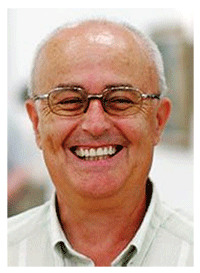
It rarely happens that an exceptionally endowed in the field of fine arts child grows later into a self-authentic and significant arts personality. Precocious fame often kindled by parents' painful ambition, has frequently led to low resistance against future hardships and misfire tunes on the part of the gifted person. Most often, this happens when the child's hierarchy of meanings, in which the young artist arranges the real of the surrounding world, gives way to a completely different hierarchy coming from the spatial and perspective relations between the big and the small and the concern over the exact reproduction of this world so complex and foreign to human fantasy...
I got to know the painter Anton Antonov at a time when he was already acquainted with the painting technique and the requirements of optic laws to such a degree, that he was already able to reproduce a three-dimensional shape, in terms of chiaroscuro and proportion, up to the most exacting standards of academically schooling. Al that time he was only 13 of age. The only danger he was to overcome was the recurrent repetition of this early professionalism in his works.
The next time I saw him was 15 years later when he had already received university education and was making art fully freed from the bounds of objectivity. His paintings freely expressed the author's artistic will-just as irresistible as if had been in the early years of his childhood. Today, together with his sensitivity towards line and colour, Anton Antonov revealshis rich and refined intellectual character, which manages to harness the power and sharpness of his sensual perception on every occasion when his innermost world collides with outside reality.
A typical feature of his painting is that it never compromises in favour of means of expression foreign to his nature. He pursues neither purely graphical effect to enrich the composition's line pattern, nor volume suggestions to enhance the objects' material significance in the spectator's perception. His painting is always subordinate to colour, even when it is rendered in nuance and as a tonal unity, even when it comprises drastically contrasting values of warm and cold. This kind of painting has borrowed from impressionism, a system based upon mutually contrasting colors, everything voluble, and has added to it the fury of emotion inferred by expressionism.
Impressionism and expressionism are so inextricably interwoven in Anton Antonov's works, that to us, the audience, it is all the same whether the painting is set in the nature or completely free from it. Because in either case the painting represents the autor's unreachable abode, invulnerable in terms of its aesthetically value and plasticity.
And it is this relation with the plastic values of Painting, a relation that doesn't need other names from outside the traditional cultural model, that makes the audience trust the author, however hard it may be to penetrate into the painting's autonomous world. Having once steeped inside this world of art, the spectator feels free and comfortable as if it were the world of the classical painting.
This is why we have solid grounds to classify Anton Antonov's painting as an entirely modern message of value and meaning rooted in the world of classical art. In other words, even within the context of contemporary developments in art, the author manages to convince us, just the way Cezanne once did, in his ability of making modern, in its aesthetically suggestion, art that remains just as lasting in time as the classical art exhibited in museums the world over.
Maximilian Kirov - art Critic

Through the years Anton Antonov shaped as an author with his own individuality. He follows a natural and lyrical way of development. The different tendencies in the evolution of contemporary art – the Bulgarian one from the beginning of the 20-th century, the European one in the person of the Paris school, undoubtedly have been the landmarks way of development. But what helps him bring together these different ways in one own and uniform lyrical figurativeness, are the strong basis of the mastered lessons of his professional education as well as the incentives of nature. His paintings cannot be “washed away” among those of the other artists. They can be distinguished. Lines follow the unshackled figuration; colorful stains live independently, on their own, out of the plastically built subject. The characterization of the genre is not end in itself. The effort is directed toward the achievement of the character of the Painting itself. There is a self-controlled lyricism going out of the canvases, for which is inherent a universal simplicity of the image and intellectual finesse. This combination of intellectual genesis which isn’t notionally rational but is “warmed up” by the authentic artistic sensitivity makes Anton Antonov a unique and original phenomenon in our contemporary art.

